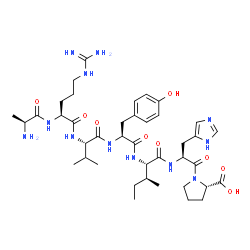1176306-10-7
| Name | Angiotensin A (1-7) trifluoroacetate salt |
|---|---|
| Synonyms |
L-Alanyl-L-arginyl-L-valyl-L-tyrosyl-L-isoleucyl-L-histidyl-L-proline
L-Proline, L-alanyl-L-arginyl-L-valyl-L-tyrosyl-L-isoleucyl-L-histidyl- |
| Description | Alamandine, a member of the renin-angiotensin system (RAS), a vasoactive peptide, is an endogenous ligand of the G protein-coupled receptor MrgD. Alamandine targets to protect the kidney and heart through anti-hypertensive actions[1][2]. |
|---|---|
| Related Catalog | |
| In Vitro | Alamandine is generated by catalysis of Ang A via ACE2 or directly from Angiotensin 1-7 (Ang-(1-7)). Derived from angiotensin II (Ang II) by Ang II-converting enzyme 2 (ACE2), it shows vasodilating (thus protective) properties. Ang (1-7) can be decarboxylated to a peptide called Alamandine. Alamandine is also an endogenous peptide identified in human blood[1]. Alamandine elevates cAMP concentration in primary endothelial and mesangial cells, also suggesting Gs coupling[2]. Alamandine decreases secretion, expression, and blood levels of leptin. Alamandine induced expression of iNOS and plasminogen activator inhibitor-1 (PAI-1) in adipose tissue and isolated adipocytes[2]. |
| In Vivo | Alamandine (0.15 μL/h; administered by mini-osmotic pumps; for 6 weeks) treatment ameliorates hypertension and impaires left ventricle (LV) function in SHRs. Also decreases the mass gains of heart and lung in SHRs, suppresses cardiomyocyte cross-sectional area expansion, and inhibits the mRNA levels of atrial natriuretic peptide and brain natriuretic peptide[3]. Animal Model: Male spontaneously hypertensive rats (SHRs, 50-week-old)[3] Dosage: 0.15 μL/h (~50 μg/kg/day) Administration: Administered by mini-osmotic pumps; for 6 weeks Result: Attenuated hypertension, alleviated cardiac hypertrophy, and improved LV function. |
| References |
| Density | 1.4±0.1 g/cm3 |
|---|---|
| Molecular Formula | C40H62N12O9 |
| Molecular Weight | 854.995 |
| Exact Mass | 854.476257 |
| LogP | 0.12 |
| Index of Refraction | 1.657 |
| Storage condition | -20°C |
